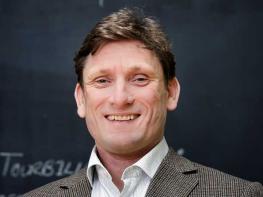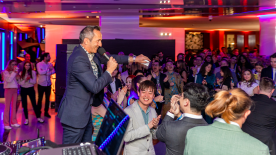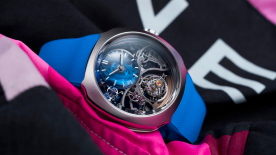British-born Stephen Forsey, co-founder with Robert Greubel of Greubel Forsey, has taken to Swiss life like he was born here. He lives on a farm in the countryside and he speaks French almost better than English. It’s been 11 years since he and his partner started the company, so WorldTempus took the opportunity to ask him five good questions.
What is the secret of your success?
It’s a question of spirit, we have always questioned each existing fact and always want to overcome the limits of what was believed possible.
Robert and I noticed when we started to work on our first timepiece that many skills and techniques – notably for hand finishing – were no longer practiced. So we were looking already then, ten or fifteen years ago, at the challenge to save these watchmaking skills and techniques from the dying out.
What are three of your favorite projects so far?
The technical development of the Double Tourbillon 30°, the Invention Piece 1 for its original ground breaking mechanical architecture and the GMT for its architecture. All these timepieces embody the true Greubel Forsey spirit, a passion for research and creativity applied to a seemingly “simple” idea and transforming it into an extraordinarily original timepiece.

The Tourbillon 24 Secondes Vision, which follows the line initiated by the Double Tourbillon 30° Vision, is a sublime piece, apparently simple at arm’s length, with the exquisite details and level of outstanding execution become more and more apparent the closer that you look.
I particularly like its elegant and slender proportions and a beautiful subtle vertical asymmetry with the sapphire crystal dome, invisible from the display side, which enables a unique view of the unique fast rotating 24 seconds tourbillon cage and completes the movement architecture.
What were the unique challenges that the Vision presented?
One of the most difficult aspects of the creation process was to design a timepiece that was more subtle and elegant without losing sight of our atelier’s DNA and vision. The inclination of the tourbillon cage was of the outmost importance and this is one of the reasons why we thought of adding the sapphire glass dome on the back of the case. However, we needed to ensure it would be comfortable for our collectors to wear so we spent ample time creating prototypes with 3D printers and testing it for comfort.
We wanted the Tourbillon 24 Secondes movement to be one of the main attractions of the timepiece. However, we also wanted to continue to highlight our expertise in hand finishing. For example, from afar it may look like the timepiece has a quite simple dial but in reality it lives up to every measure of Greubel Forsey standards. The hand-finished blued-steel hands have been lightened and shaped in a lance-form specifically so they can lead the eye straight to the engraved and oven-fired enamel indexes. These are oven-fired 7 to 10 times in order to ensure ideal finish, without any imperfections. This is really difficult as even a fraction of a second can make all the difference between a Greubel Forsey-approved dial and one that we don’t feel is good enough to send out the door.

Last but not least we are really proud of the tourbillon bridges, the lower bridge was one of the main reasons we use a sapphire crystal dome; we wanted to draw attention to it. The bridge is arched, barreled and delicately polished by hand, resulting in a perfectly regular reflection over the whole piece. Such expertise is required that initially only one specialist in our decoration department was able to finish this bridge to our standards.
What do you love about what you do?
I love pushing back the frontiers of performance through our original research; to see a new invention burst into life and working for the very first time.
Bonus question: What do you love about watches?
Time is invisible but governs our lives. The mechanical watch is the finest combination of art, science and mechanics I have ever found!
I inherited my father’s and grandfather’s passion for the intricacies of mechanics, then discovered antique horology through clocks and the mechanical watch at horological school in London. The fascination of the unique nature of watchmaking, mechanics, creativity, artistry, rigor, precision are all important facets of fine watchmaking.








